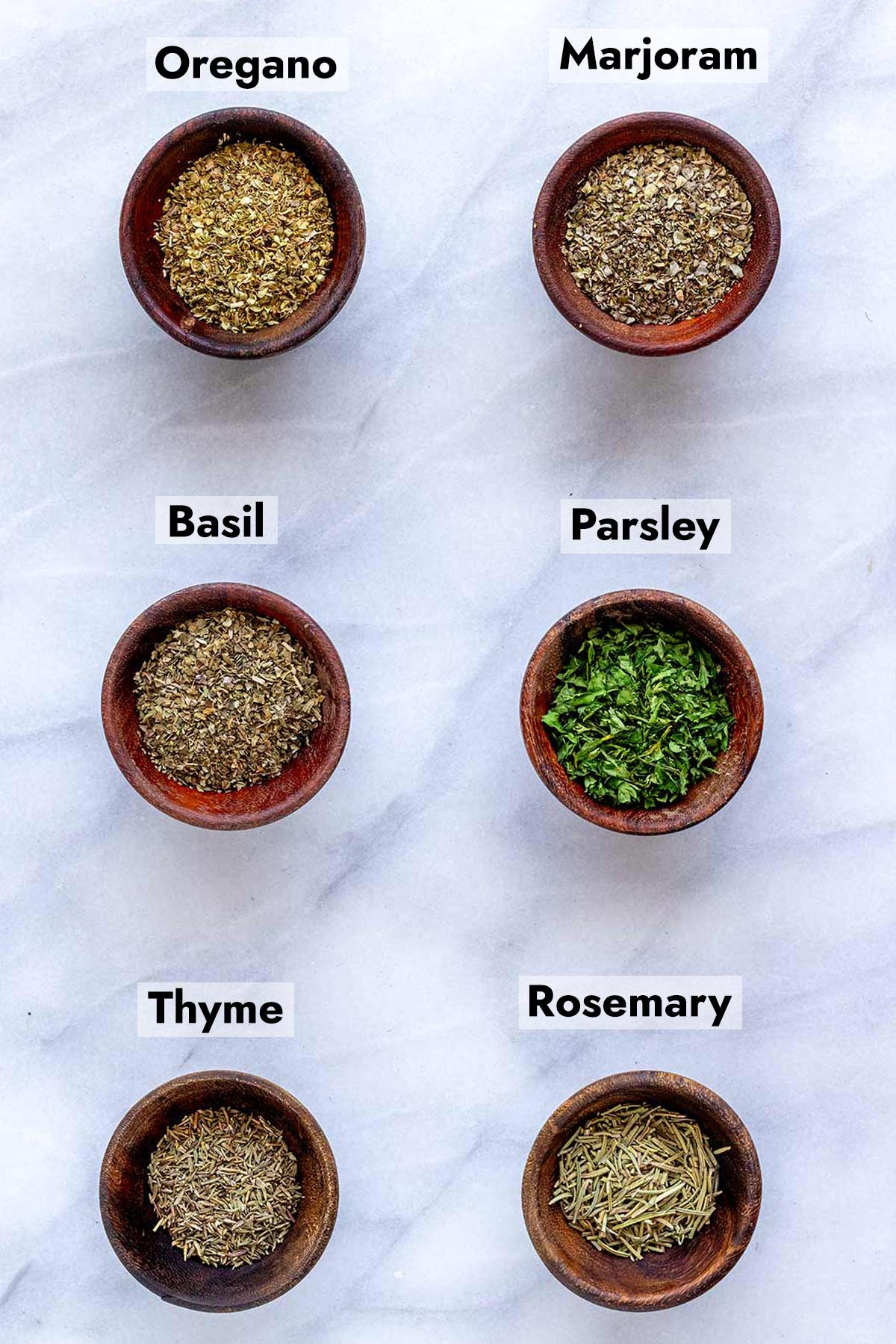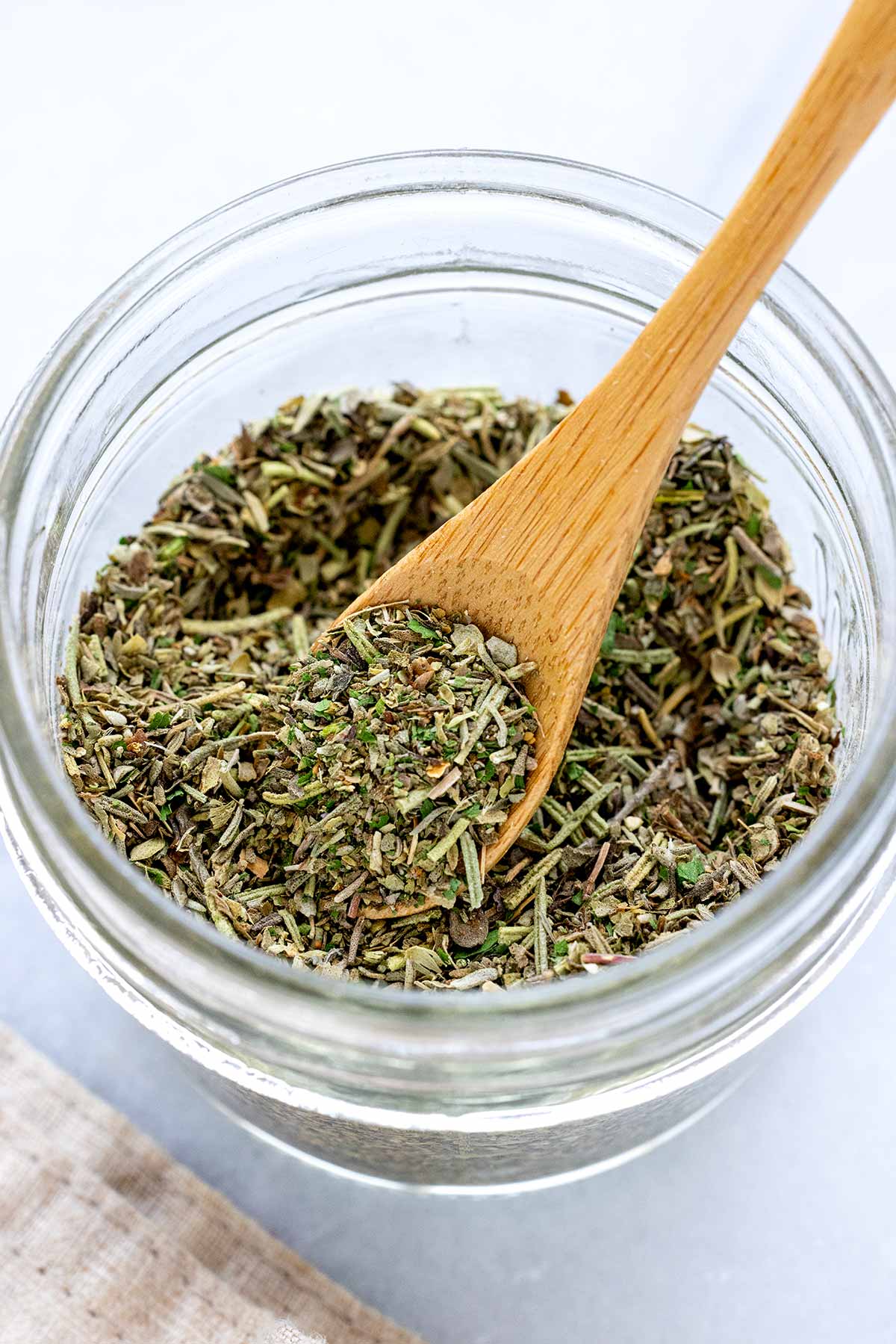Elevate your dishes with this homemade Italian seasoning recipe! This flavorful blend of herbs is perfect for adding to meats, seafood, sauces, soups, and pasta. Keep it handy in your pantry for an easy flavor boost in any recipe.

Recipe Science
- Dried herbs have concentrated flavors due to dehydration, which intensifies their natural oils.
- Oregano, marjoram, basil, parsley, thyme, and rosemary create a well-balanced Italian seasoning that’s earthy, sweet, and aromatic.
- Cooking the dried herbs in oil first helps bloom their fat-soluble flavors, enhancing the overall depth of the dish.
Jump To a Section
Why It Works
Homemade Italian seasoning is a simple yet powerful way to elevate everyday dishes with vibrant flavors. As a home cook, making your own blend ensures the best-tasting results compared to store-bought versions that often lose potency over time. The herb mix stores for a long time in the pantry, making it easy to grab and use in your next Italian meal.
This recipe combines a well-balanced mix of dried herbs like oregano, marjoram, basil, parsley, thyme, and rosemary. This versatile blend enhances Italian recipes from pasta sauces and roasted vegetables to marinades and salad dressings. With just a few pantry staples, you’ll have a flavorful seasoning that adds an authentic Italian touch to your meals.
Ingredients You’ll Need

- Oregano: Dried oregano has a strong, camphor-like aroma and a bold, slightly bitter flavor with earthy, green, hay, and minty notes. Its astringent mouthfeel adds depth and balances sweeter herbs like basil in the blend.
- Marjoram: Dried marjoram has a mild, sweet flavor with fresh, woody, citrusy, and floral notes. It’s less bitter than oregano, adding a subtle complexity.
- Basil: Dried basil adds subtle notes of anise, mint, pepper, and a hint of sweetness.
- Parsley: Dried parsley has a mild, clean taste with earthy, grassy notes and hints of mint and citrus, adding freshness and balance
- Thyme: Dried thyme has an earthy flavor balanced with citrus, mint, and woody floral notes. It adds a peppery, sweet taste with a hint of clove, bringing depth and complexity to the blend.
- Rosemary: Dried rosemary has a strong, earthy, woodsy flavor with hints of pine, citrus, pepper, and mint. Its intense taste adds depth, so I use smaller amounts.
See the recipe card below for all ingredients and measurements (US and metric).
Ingredient Substitutions
This recipe for Italian seasoning is easy to customize! Try these delicious additions:
- Savory: Dried savory is most common in store-bought products. It has an earthy, subtle flavor with notes of marjoram, thyme, and mint. Feel free to add it if it’s available at the market.
- Sage: Try adding dried sage to the seasoning. It has an earthy, herbal flavor with a slightly peppery taste and hints of mint, eucalyptus, and lemon. Add a small amount to start, as the taste is strong.
- Alliums: Add garlic powder or onion powder for a roasted allium note. I often add them separately in Italian dishes, which is why it’s not included in the recipe.
- Make it Spicy: Red pepper flakes add a lingering heat to the seasoning. Add ¼ teaspoon to start, and increase to the desired capsaicin level. This is great if you prefer spicier sauces, dips, or proteins.
- Add Salt and Pepper: If you want to use Italian seasoning mix to flavor food, add kosher or sea salt to the blend. Add black pepper for a mild heat. Add about ¼ to ½ teaspoon, adjusting to the desired flavor level as needed.
How to Make Italian Seasoning

Step 1: Combine the Herbs
Combine dried oregano, marjoram, basil, parsley, thyme, and rosemary in a small bowl.

Mixing these dried herbs at home gives you more control over the flavor profile than buying store-bought versions.
Pro Tip: Each dried herb has a distinct shape—parsley is bulkier, and rosemary has a needle-like texture. You can gently crush the herbs with your hands to create a more uniform blend that’s easier to sprinkle. Be careful not to break them down too much; you don’t want a fine powder. If you’re using a measuring spoon to portion the herbs, there’s no need to break them up. Keep the herbs whole for the best texture.

Step 2: Store
You can immediately use the Italian seasoning for your dish or store it in an airtight container. I prefer to store it in a small glass jar, similar to the ones the herbs or other spice blends are sold in. That way, it will stay fresh for a longer time, about 6 months, in a cool, dark, and dry area of the kitchen.
Expert Tip: Storing your herbs in a glass jar is one of the best ways to keep them fresh and flavorful. Glass is non-reactive, meaning it won’t absorb or alter the delicate aromas of the herbs. Plus, it creates an airtight seal that protects them from moisture and air exposure, which can cause them to lose their potency. It’s also super easy to clean and doesn’t retain any lingering odors, so your herbs stay fresh.
Ways to Use Italian Seasoning
Now that you’ve mastered the best Italian seasoning recipe, here are some delicious ways to use it to elevate your dishes:
- Pasta Sauces: Stir it into marinara sauce, alfredo sauce, or any tomato-based sauce for an extra flavor boost.
- Meat: It’s a stable ingredient in my Italian meatball recipe. You could also use ground turkey or chicken.
- Breading: Combine the Italian seasoning blend with homemade bread crumbs to make a coating for chicken Milanese.
- Roasted Vegetables: Toss your veggies in olive oil and Italian seasoning before roasting for a savory herb crust. Try my roasted mushrooms.
- Marinades: Add it to chicken marinade or steak marinade to infuse the meat with aromatic flavors.
- Homemade pizza: Sprinkle it on your pizza dough or sauce to give your pie a classic Italian taste.
- Soups and stews: Stir it into broths for a warm, comforting herbal flavor like in my minestrone recipe.
- Garlic Bread: Mix Italian seasoning into butter or olive oil and brush it over bread before toasting for the perfect herbed garlic bread.
- Salad dressings: Whisk it into vinaigrettes or creamy dressings for an easy way to add herbaceous notes. I always add it to my Italian dressing or Italian pasta salad.
Frequently Asked Questions
The base herbs are dried oregano, marjoram, basil, parsley, thyme, and rosemary. Other herbs, such as sage and savory, may be added. Some homemade spice blends may include salt, pepper, garlic, onion, fennel or red pepper flakes. It’s easy to customize your spice blend!
Use equal parts of dried oregano (or marjoram) and basil as substitutes for Italian seasoning. Herbes de Provence is a good swap, which typically includes thyme, rosemary, basil, marjoram, savory, bay leaf, fennel, chervil, and tarragon. Some blends also include lavender, which may overpower the dish if used in a large amount as a substitute in a recipe.
Oregano and marjoram are interchangeable, though oregano is more pungent. Substitute dried parsley with cilantro, basil, or oregano. Dried thyme can be swapped with oregano, marjoram, or savory for similar earthy flavors. For dried rosemary, use thyme, sage, or savory for their woodsy notes.
The amount of Italian seasoning depends on the dish, but a good starting point is 1 to 2 teaspoons per pound of meat or a pot of sauce. For soups, stews, or marinades, start with 1 teaspoon and adjust to taste. For the best flavor, mix it or cook it in oil first to help extract the fat-soluble flavors, giving your dish a deeper, more balanced taste. You can always add more if needed, but it’s easier to add than take away!
More Seasoning Recipes
If you tried this Italian Seasoning Recipe, please leave a 🌟 star rating and let me know how it went in the 📝 comments below!
Italian Seasoning

Ingredients
- 1 tablespoon dried oregano
- 1 tablespoon dried marjoram
- 1 tablespoon dried basil
- 1 tablespoon dried parsley
- 1 ½ teaspoons dried thyme
- 1 ½ teaspoons dried rosemary
Instructions
- Combine the Herbs – In a small bowl, mix the oregano, marjoram, basil, parsley, thyme, and rosemary.
- Store – Transfer Italian seasoning mix to an airtight container or jar.
Recipe Video

Notes
- Recipe Yield: About 5 tablespoons
- Serving Size: 1 teaspoon
- Marjoram Substitute: Use oregano to replace the marjoram.
- Storing: Store in an airtight container in a cool, dry, dark place for about 6 months.
Nutrition Facts
Percent Daily Values are based on a 2000-calorie diet. All nutritional information is based on estimated third-party calculations. Each recipe and nutritional value will vary depending on the brands you use, measuring methods, and portion sizes per household.









Leave a Comment